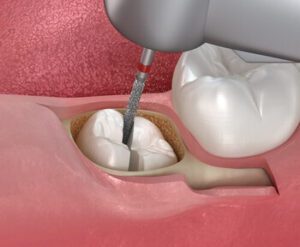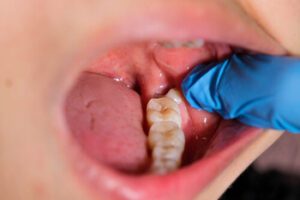Seeing white stuff in wisdom tooth hole after extraction can be alarming, especially if you’re not sure what’s part of the normal healing process and what could be a sign of trouble. While it’s common to spot a white or yellowish material in the tooth extraction site, understanding what it is and when to seek help can make all the difference in your recovery.
In this guide, we’ll walk you through the typical healing stages after wisdom tooth extraction, explore what the white substance might be, and explain when that white stuff is completely normal and when it might indicate a complication like dry socket or infection.
Understanding the Healing Process After Wisdom Tooth Extraction
 Healing after a wisdom tooth extraction is a complex biological process. The body kicks into gear almost immediately after the tooth is pulled, sending white blood cells and blood vessels to the area to start the repair process. A normal socket forms once a blood clot forms in the empty tooth socket. This clot protects the extraction site, shields underlying bone and nerves, and lays the foundation for new gum tissue and bone growth.
Healing after a wisdom tooth extraction is a complex biological process. The body kicks into gear almost immediately after the tooth is pulled, sending white blood cells and blood vessels to the area to start the repair process. A normal socket forms once a blood clot forms in the empty tooth socket. This clot protects the extraction site, shields underlying bone and nerves, and lays the foundation for new gum tissue and bone growth.
Once the tooth-extracted area begins healing, you might notice changes in colour, texture, or even taste. While much of this is completely normal, it’s important to understand each phase.
What Is the White Stuff in a Wisdom Tooth Hole?
The “white stuff” you notice in your wisdom tooth extraction site could be several things. Here’s a breakdown of what it typically is and isn’t:
1. Granulation Tissue
Most commonly, that white or cream-coloured substance is healing granulation tissue. This is called granulation tissue and forms naturally during healing. It’s composed of white blood cells, new blood vessels, and collagen, and replaces the initial blood clot. This fragile tissue helps close the tooth socket and rebuild the area. It might appear whitish, yellowish, or greyish and is often confused with pus or infection, but it’s actually a normal part of healing.
2. Food Debris
If you’ve recently eaten, especially without rinsing properly, you might have food debris or stuck food particles lodged in the socket. This can resemble a pale or yellowish substance and may come with a bad taste in your mouth. Rinsing gently with warm salt water can help dislodge this.
3. Surgical Material
Sometimes dentists use medicated dressings or dissolvable stitches after wisdom teeth removal. These can look white or creamy and are part of the post-surgery routine. They’re harmless and typically dissolve on their own.
4. Pus or Signs of Infection
If the white substance is accompanied by severe pain, gum inflammation, persistent pain, or mouth bleeding, it may indicate an oral infection. In these cases, the white stuff could be white, yellowish fluid, which requires appropriate treatment by a dentist.
Is White Stuff Always a Concern?
No, not necessarily. White granulation tissue is a key player in your body’s recovery. As the healing process continues, this tissue gradually gets replaced with new gum tissue, and the mouth heals over time.
Indicators It’s Normal:
- No worsening pain or swelling
- No bad breath or bad taste
- White tissue that stays stable and gradually shrinks
- No continuous bleeding
If these conditions are met, you’re likely seeing part of the normal healing process.
When to Be Concerned About the White Stuff
While white material is often part of tooth extraction healing, sometimes it may point to a problem, especially if paired with discomfort or other symptoms.
1. Dry Socket
One of the most common complications after wisdom teeth extracted is dry socket, a painful condition where the blood clot gets dislodged or never forms. This leaves an empty socket with exposed bone, leading to excruciating pain and slow healing.
Signs of dry socket include:
- A visible empty tooth socket
- Missing blood clot
- Worsening pain a few days post-extraction
- Bad breath or a bad taste
- No visible healing granulation tissue
Dry sockets typically occur between day 2 and day 5 post-op and require attention from a dentist.
2. Infection
 An oral infection can develop if food particles or bacteria enter the surgical site, especially if good oral hygiene isn’t maintained. Watch for:
An oral infection can develop if food particles or bacteria enter the surgical site, especially if good oral hygiene isn’t maintained. Watch for:
- White or yellow discharge
- Gum inflammation or swelling
- Fever
- Severe pain not relieved by painkillers
- Unpleasant odour or taste
How Long Should the White Stuff Last?
The presence of white substance can last for several days to even a few weeks after wisdom tooth removal. As the healing progresses, the colour and texture of the socket change. Here’s a general timeline:
Day 1–2:
- Blood clot forms
- Socket appears dark red or purple
Day 3–5:
- Granulation tissue begins forming
- May appear white or pale yellow
Week 1–2:
- Socket stabilises with visible white or cream tissue
- Mouth heals gradually with reduced discomfort
Week 3–4:
- Most white tissue disappears as new gum tissue forms
- Socket heals completely in most cases
Supporting a Healthy Healing Process
To promote proper healing and avoid complications like dry socket or infection, follow these steps:
1. Rinse with Warm Salt Water
Start rinsing gently 24 hours after surgery. This helps remove food debris, supports healing, and reduces bacteria.
2. Stick to Soft Foods
Avoid crunchy, spicy, or hot foods in the first week. Instead, opt for:
- Mashed potatoes
- Yoghurts
- Broths
- Smoothies
Soft foods reduce irritation and prevent injury to fragile tissue.
3. Avoid Dislodging the Clot
Refrain from spitting, using straws, or vigorous rinsing. These can remove the clot, leaving you at risk of missing a blood clot and a dry socket.
4. Monitor for Symptoms
Track changes in the extraction site. If you notice worsening pain, unusual discolouration, or white-yellowish fluid, don’t wait. Contact your dentist promptly.
Healing Timeline: What to Expect
The pace of recovery differs depending on how many wisdom teeth were removed, your age, and overall oral health. Here’s a quick summary:
- Day 1–2: Bleeding slows, blood clot forms
- Day 3–4: Healing granulation tissue appears
- Week 1: Discomfort reduces; tooth extraction healing, white tissue becomes visible
- Week 2: Clot fully stabilises; socket begins filling in
- Week 3–4: Most signs of healing are visible on the surface
What If the White Stuff Falls Out?
If the white stuff falls out of your tooth extraction site, it depends on what it was. If it was part of the blood clot or granulation tissue, you may experience a setback in healing, especially if followed by pain or bleeding. If you’re unsure, it’s always best to consult your dentist.
Can You Prevent White Debris From Appearing?
 Not entirely. Because most of it is healing tissue. But to prevent food debris and reduce the risk of infection:
Not entirely. Because most of it is healing tissue. But to prevent food debris and reduce the risk of infection:
- Maintain good oral hygiene
- Use a gentle rinse
- Avoid sticky or crunchy foods
- Don’t touch the healing site
Is the White Stuff the Same for All Extractions?
No. The appearance of the white material may vary depending on whether it was a simple tooth pulled or a surgical wisdom tooth extraction. Surgical extractions are more invasive and might involve stitches, deeper sockets, and longer healing, so more visible white granulation tissue is expected.
The Role of the Body’s Healing Response
When a tooth is extracted, your body launches into repair mode. This involves:
- Sending white blood cells to fight infection
- Building new blood vessels
- Producing healing granulation tissue
- Replacing damaged tissue with new gum tissue
This entire body’s healing process is what makes the socket close and regenerate properly. Spotting a white substance in the tooth extraction area is often a visible sign of this incredible biological repair system at work.
When to See a Dentist
Don’t hesitate to reach out if you experience any of the following:
- Persistent pain or swelling
- Continuous bleeding
- Worsening pain after 3–5 days
- White, yellowish fluid that looks like pus
- Exposed bone or a hollow, empty socket
Prompt care can prevent complications and get you back on track.
Final Word
Noticing white stuff in your wisdom tooth hole after an extraction can be confusing, but in many cases, it’s a normal part of the healing journey. Whether it’s granulation tissue, residual surgical material, or food particles, knowing what to expect gives you peace of mind and confidence in your recovery.
If you’re concerned about white stuff in your wisdom tooth hole or want reassurance that your healing is on track, book a consultation with us at Definitive Dental or call (02) 6105 9833.
Note: Any surgical or invasive procedure carries risks. Before proceeding, you should seek a second opinion from an appropriately qualified health practitioner.
Resources
Colgate. (2023). ‘Tips for Preventing and Treating Dry Socket’. Colgate, 9 January. New York, NY: Colgate-Palmolive Company. https://www.colgate.com/en-us/oral-health/wisdom-teeth/dry-socket-more-painful-than-the-tooth-extraction
McPhillips, A. (2024). ‘Wisdom Teeth Removal: What Adults Should Expect’. WebMD, 22 July. New York, NY: WebMD LLC. https://www.webmd.com/oral-health/wisdom-teeth-adult
Cleveland Clinic. (2022). ‘Oral Hygiene’. Cleveland Clinic, 21 April. Cleveland, OH: Cleveland Clinic Foundation. https://my.clevelandclinic.org/health/treatments/16914-oral-hygiene

